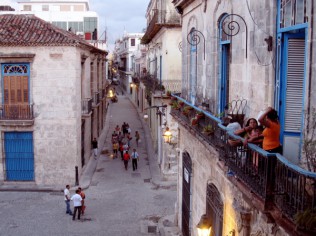In 1960, right after the revolution, Fidel Castro and Ché Guevara met on the grounds of the Havana Country Club, a golf course in the posh suburbs of the Miramar district. They posed together for pictures, played some golf and brainstormed about what they were going to do with this gorgeous monument to bourgeois manners. Ché and Fidel decided to bulldoze the club, and build in its place a world-class art school: the Higher Art Institute, which remains a distinctly Cuba mix of revolutionary transformation and erotic architecture.
We drove past the Institute during our first day—a very full day—of touring Havana, from its seaside promenade (the legendary Malecón) to the venerable streets of Havana Vieja, the heart of the nearly 500-year-old city.

“The best thing about Cuba is the people,” he said, responding to a two-sided question from a group member. “And the worst thing? That Cuba must change—even though we don’t necessarily want it to.”
He’s right on the first account. The warmth of the Cuban people is genuine, infectious, and—given their economically repressed situation — miraculous. During my first days here I haven’t met a soul who is rushed, materialistic, or grudging.
Eighty percent of Havana, Coyula told us, was built between 1900 and 1958. Though only 0.7% of the country’s land is in Havana, it produces a third of the country’s GDP. Havana, he’d tell us repeatedly, is Cuba’s most important resource—but it’s not being used properly.
The second observation is equally obvious. Cuba must change—is changing, and fast—which is one of the reasons I wanted so badly to visit now rather than, say, three years from now. Under the leadership of Ra˙l Castro, limited private entrepreneurship is taking hold. It’s piecemeal now, and clumsy, but it won’t stay that way for long.
Old Havana is already seeing signs of major regentrification. Crumbling facades, buildings and entire squares have been transformed into beautiful hotels and plazas. Amid the colonial buildings around Plaza de la San Francisco there is now a United Colors of Benneton, a huge window display for Victorinox, and a British fashion store. There are perfumeries, art galleries, even a Museo de Chocolate.
But Cuba remains a socialist state, and the livelihoods of almost all Cubans still depend on government programs. A few blocks further, near the bookstalls circling the Plaza des Armas, we visited a free market produce shop. It’s literally free; a ration book entitles all Cuban families to a selection of calorie-building fruits, meats and vegetables each month, based on what’s available. Next door to that was a subsidized dry goods store, where limited amounts of rice, powdered milk, sugar and other items (even cigarettes) can be purchased at deep discounts. My impression, so far, is of a society that looks after its people, and considers nutrition and health care human rights.
I bought a paper cone of peanuts for 300 centavos and popped them into my mouth as we wandered through the cobblestone alleys. The conversation turned to how much commerce was enough for Cuba, and how much influence western goods and capitalism might ultimately have on this socialist regime.

Cuba, Coyula believes, could be a model of mindful development, as impressive as Brazil. But lacking Brazil’s copious oil, it must develop a green strategy: meeting the current energy needs with organic products left over from the annual sugar harvest. “Forty percent of our energy needs,” he guesses, “can be met with straw and biomass.”
The ace in the hole, though, is Cuba’s capacity for innovation, borne out by a stellar biotech industry and a plethora of science-minded graduates. “When the USA gets used to Cuba”—that’s how he phrased it—”Science will emerge as the most important field for cooperation and industry.”
That brings up the question of the embargo itself—a policy that prevents Cuba from importing any high-tech or industrial vehicles or machinery with American-made parts or technology—even if they’re assembled in Asia or Europe. Will Obama be the one to thaw this half-century freeze?
Coyula shook his head. “No U.S. president will end the embargo,” he said. “Slowly, it will simply collapse.” He may be right. This fall, several new U.S. airports (including Oakland and Los Angeles) may begin offering direct flights to Cuba. “People are already telling me they want to start travel agencies. The more travel agencies, the more need for hotels, large and small. Which means more restaurants and shops. Eventually, we’ll look around and see that the embargo exists in name only.”

The problem is that the country needs money, fast. So the government itself is looking at the most expedient ways to turn tourism—already up almost 60% from last year—into a cash cow. They already have some development plans.
“Right now,” Coyula remarks with ill-disguised irony, “the authorities are betting on golf courses.”
Read Ethical Traveler's Reprint Policy.
